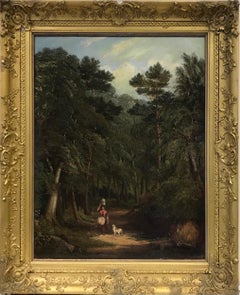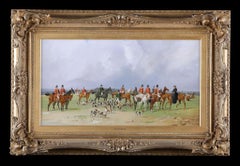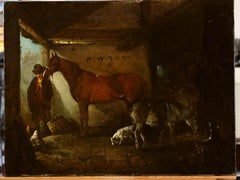Edward Robert Smythe Art
Edward Robert Smythe was born in Ipswich, U.K., in 1810 to James Smyth and Sarah Harriet née Skitter. Edward attended the school of Robert Burcham Clamp and had a liking for a military career but his love of art took his fancy. Elected a member of the Ipswich Society of Professional and Amateur Artists in March of 1832 and attended his first meeting on November 18th, where he was probably working under Henry Davy and met many local artist members. In his younger days he had a studio in the Old Shire Hall, Ipswich, where he painted with such artists as Samuel Read, Walter Hagreen, Frederick Russel and Robert Burrows.
Around 1840, Smythe moved to Norwich to study the Norwich School of painting, where he became acquainted with Robert Ladbrooke’s son, Frederick, and is said to have worked with John Sell Cotman but returned to Ipswich some five years later, taking a house in Bramford Road. He married at Ipswich in 1848 — Ellen Bowman of Ipswich — and there, his first child, Edward Robert, was born the following year. In 1851, he lived in Elmswell, Suffolk with his 24-year-old wife, Ellen, and son but later that year moved to 3 Angel Hill, Bury St Edmunds, where he kept company with his friend Fred Ladbrooke. By 1861, still at Angel Hill, they had more children at Bury St Edmunds: Francis (Frank) Rowland 1852, Ellen Kate 1854 and Mary Emily 1856, their daughter Louisa Jane, died at Angel Hill, Bury St Edmund’s on April 7, 1861, aged three years and seven months. He exhibited at the Suffolk Fine Arts Association at the New Lecture Hall of the Mechanics' Institution, Ipswich, in August 1850, several oil paintings including "Chapel Viaduct, Colne Valley," "A Group of Animals," "A Sketch Ploughing," "Ponies and a Dog" and "A Landscape" and a watercolour "The Ruling Passion strong in Death" and was also a member and exhibitor at the Ipswich Art Club 1886–98. He also exhibited five works at the Royal Academy, including "View in the Colne Valley at Chappel, Essex" and exhibited five works at the British Institution, including "Pony and Boy" and "The Village Blacksmith."
In 1865, Edward was living at 98 Risbygate Street, Bury St Edmunds, and his wife died at 69 Risbygate Street, Bury St Edmunds in 1879, aged 52. By 1891, he had moved in with his married daughter Ellen Kate, who had married George Robert Chilvers, a tobacco manufacturer, at Burlington Lodge, 30 Burlington Road, Ipswich, where he died on 5 July 1899, aged 88, and was buried in Ipswich cemetery three days later. Five of his paintings were on show at the Centenary exhibition of the Ipswich Art Club in 1974 — a pastel, "Crossing the Stream" and oils "Beach Scene," "Knife Grinders" and "The Squires Son" and a drawing "Gipsies by the Wayside." Over the years, he has regained some of the prestige that he held during his lifetime, and his oil "Woolpit Horse Fair" fetched £39,650 at Bonhams London auction in 2011.
19th Century Victorian Edward Robert Smythe Art
Oil
19th Century Victorian Edward Robert Smythe Art
Oil
1890s Victorian Edward Robert Smythe Art
Canvas, Oil
1840s Victorian Edward Robert Smythe Art
Oil
1850s Victorian Edward Robert Smythe Art
Canvas, Oil
1910s Victorian Edward Robert Smythe Art
Canvas, Oil
19th Century Victorian Edward Robert Smythe Art
Oil, Canvas
19th Century Victorian Edward Robert Smythe Art
Canvas, Oil
19th Century Victorian Edward Robert Smythe Art
Oil
1840s Victorian Edward Robert Smythe Art
Oil
1890s Victorian Edward Robert Smythe Art
Oil, Canvas
1850s Victorian Edward Robert Smythe Art
Oil
19th Century Victorian Edward Robert Smythe Art
Canvas, Oil
Early 1900s Victorian Edward Robert Smythe Art
Oil
Mid-19th Century Victorian Edward Robert Smythe Art
Oil
19th Century Victorian Edward Robert Smythe Art
Oil
19th Century Victorian Edward Robert Smythe Art
Oil



